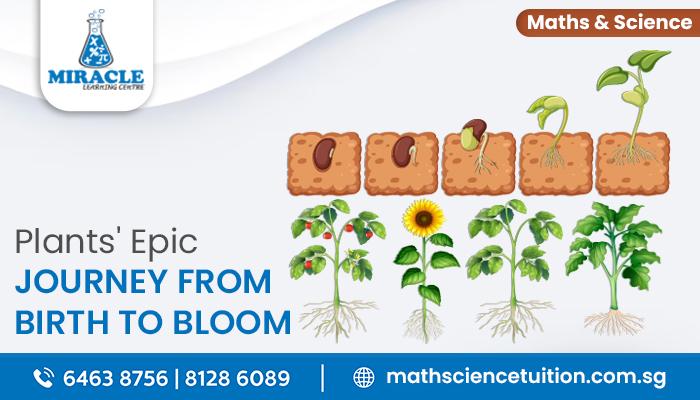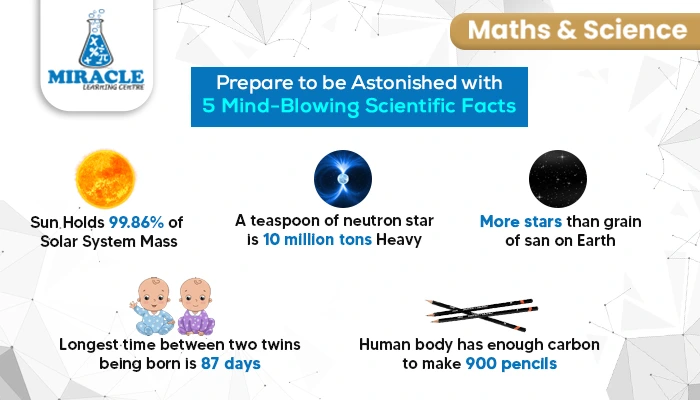Plants, those fascinating organisms that blanket our Earth in a myriad of colours and forms, have a captivating life cycle that mirrors their diversity and resilience. From the tiniest seed to the majestic adult plant, the journey of plant life is a symphony of growth, adaptation, and reproduction. At Miracle Learning Centre, we believe in unravelling the captivating mysteries of the natural world. In our Science tuition centre, our expert tutors delve into the captivating life cycle of plants, exploring the remarkable journey from birth to the adult stage. In this blog, we explain in-depth details about the intricate stages of a plant’s life cycle. Let’s begin this exciting exploration.
What is Plant’s Life Cycle?
The life cycle of a plant encompasses the series of stages a plant goes through as it grows, reproduces, and perpetuates its species. This cycle ensures the continuity of plant populations and has evolved over millions of years to adapt to various environmental conditions. Understanding the plant’s life cycle provides insights into plant biology, ecology, and agricultural practices.
Stages of Plant’s Life Cycle:
The journey of plant life commences with the seed, carefully embedded in the soil through diverse means. From this seed emerges the germination process, giving birth to initial leaves referred to as seedlings. Subsequently, the plant embarks on a journey of growth, maturing into its adult stage. This phase is marked by pollination, the formation of seeds, and the prospect for the species to perpetuate its existence by initiating the life cycle anew.
The plant life cycle can be divided into six primary stages:
- Seed
- Germination
- Seedling
- Adult Plant
- Pollination
- Seed Dispersal
Seed:
The journey begins with a tiny, seemingly lifeless seed. The seed carries the genetic blueprint of the plant and is equipped with nutrients to fuel its initial growth. It is a dormant stage, waiting for the right conditions to sprout. Some seeds may lay dormant for years until factors like moisture, temperature, and light trigger their germination.
Germination:
When the conditions are right, the seed awakens from its slumber. It absorbs water, swells, and eventually cracks open as the embryonic root, known as the radicle, emerges. Simultaneously, the shoot or embryonic stem pushes upwards towards the light. This marks the beginning of the plant’s active growth phase.
Seedling:
As the shoot continues to elongate, the first leaves, or cotyledons, unfurl. These initial leaves provide the plant with its first taste of photosynthesis, generating energy from sunlight. The seedling requires proper care, including water, nutrients, and protection from harsh elements, to ensure its healthy development.
Adult Plant:
With continued growth, the plant transforms from a vulnerable seedling into a robust adult plant. It develops a stronger root system, stems, and an increasing number of leaves. The primary focus shifts from growth to reproduction, as the plant prepares to produce flowers.
Pollination:
Flowers are the epitome of a plant’s reproductive journey. They contain male and female reproductive organs necessary for the creation of seeds. Pollination, the transfer of pollen from the male to the female parts of the flower, can occur through various mechanisms: wind, water, insects, birds, or even self-pollination. This crucial step ensures the fusion of gametes and the production of seeds.
Seed Dispersal:
Once the flowers have been pollinated and seeds are formed, the plant employs ingenious methods to disperse its seeds. Wind, water, animals, or even self-propulsion mechanisms help seeds find new locations to germinate. This dispersal strategy minimizes competition among offspring and enables the plant to colonize new habitats.
Life Cycle of Seedless Plants:
The life cycle of seedless plants, such as ferns and mosses, differs slightly from that of seed-bearing plants. These plants reproduce through spores rather than seeds. Spores are small, reproductive units that can be produced in large quantities. When conditions are favorable, spores develop into gametophytes, which bear gametes (sperm and eggs). The fusion of these gametes results in a zygote, which eventually grows into a new sporophyte plant, completing the cycle.
How to learn more about it with science tuition?
Delving into the captivating world of a plant’s life cycle can be immensely rewarding, especially when guided by expert educators through science tuition. Science tuition provides students with personalized learning experiences, interactive sessions, and hands-on experiments, enabling them to grasp the intricacies of plant biology in a dynamic way. By enrolling in science tuition, learners can ask questions, engage in discussions, and deepen their understanding of plant life cycles beyond textbooks and lectures.
At Miracle Learning Centre, we offer an exceptional science tuition experience that goes beyond the classroom. Our specialized science tuition centre provides a platform where we nurture curiosity and understanding of plant life cycles. Through interactive sessions and personalized guidance, we empower students to explore the wonders of nature. With our dedicated educators, engaging discussions, and hands-on experiments, students can delve into the captivating world of plant biology.
Conclusion:
The life cycle of plants is a testament to the resilience and beauty of the natural world. From the humble seed to the vibrant adult plant, each stage holds unique significance in the survival and perpetuation of plant species. As we marvel at the intricate mechanisms of germination, pollination, and seed dispersal, we gain a deeper appreciation for the delicate balance of nature. Through science tuition and exploration, we can uncover the mysteries of plant life cycles and embark on a journey of discovery that enriches our understanding of the world around us.
We take satisfaction in revealing these botanical mysteries at Miracle Learning Centre through our specialized science tuition. Students experience the stages from seed to maturity under the guidance of our knowledgeable educators, developing a comprehensive understanding of the life of the plant kingdom. Our science tuition centre fosters curiosity and comprehension by letting students explore the mysteries of seed germination, pollination, and spread. With our help, the fascinating journey of plants comes to life, displaying the astounding web of life that exists on Earth.


